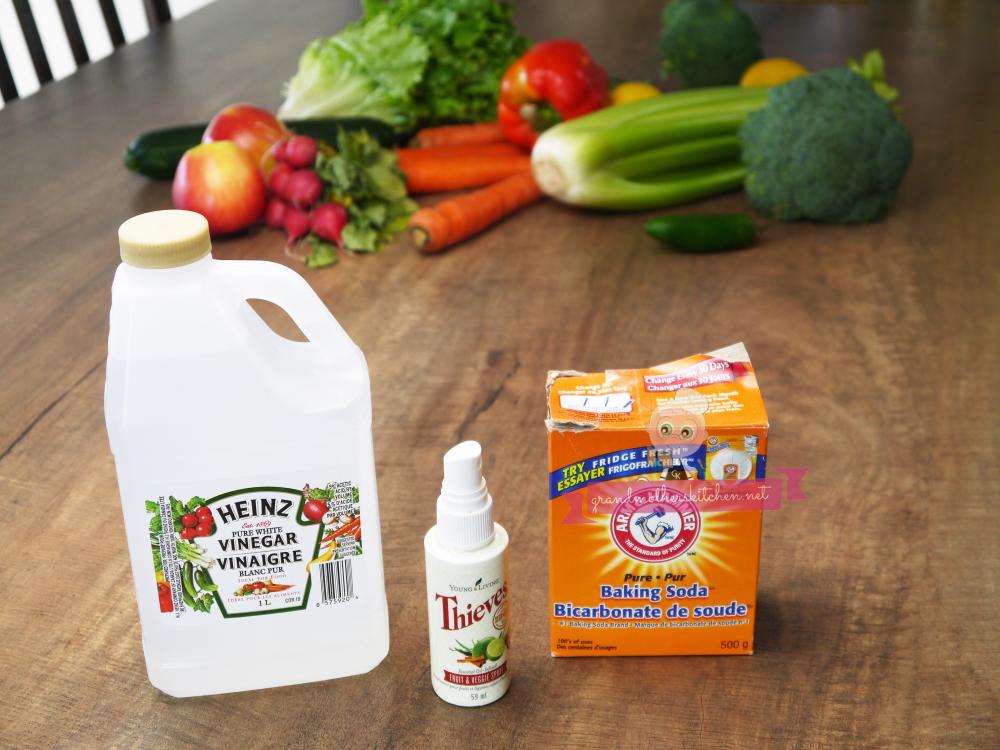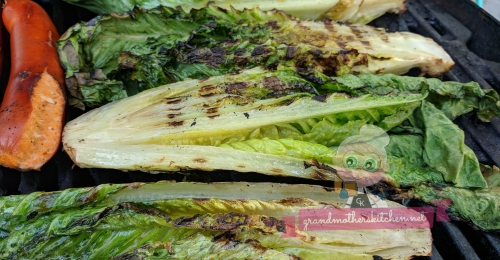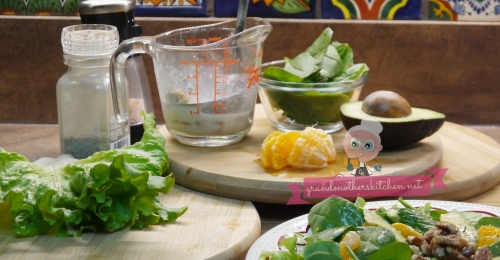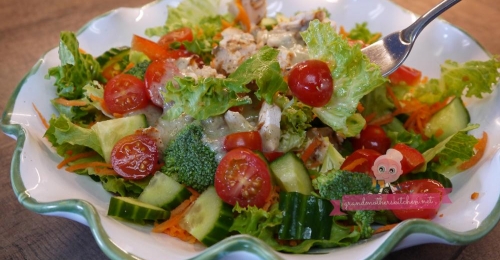Grandmothers Guide to Washing Fruits and Veggies

About this Recipe
Grandmother’s Guide to Washing Fruits and Veggies
Fresh salads of all varieties are a big part of Grandmother’s Kitchen meals. Check out a few of Grandmother’s Salad Recipes and keep an eye on this category since it will be one that we like to add to frequently.
Why Bother Washing Fruit & Veggies?
Grocery stores are dirty. A study from 2016 found that certain bacteria (like Staphylococcus aureus) is MORE common on grocery store touch screens than on hospital touch screens.(1) This right here is good enough for me, but I will give you more reasons below.
Be honest. Think how often you use your own touch screen phone when you are out and about. How often do you wash it? How often do you wash your hands BEFORE you handle produce that other people might eat? If you said “all the time”, then you are a rare human. I will assume that when ‘out and about’ most people pick up and handle produce without washing their hands first, and this is just the shoppers.
A 2016 study (2) was conducted on a carrot farm to simulate the probable effects of a field worker with poor hand washing practices that had returned to work too quickly after recovering from an infection by an enteric pathogen. If hand washing was not adequate - than hand contamination after using the field toilet transferred contamination to carrots.
Ugg right? Do we need to say more. Whether it is in the field, in the grocery store, or from a fellow shopper - fruit and vegetables can have bacteria, fungi and other microbes that I simply just don’t want to eat.
Can Washing Fruit and Vegetables Remove Pesticides?
A 2017 study (3) compared pesticides left on apples after using either a)bleach or b) regular baking soda to soak and wash the produce. The baking soda showed to be more effective than bleach. (Not that I would ever use bleach to wash apples anyways).
Still - the study found that using a 10 mg/mL baking soda washing solution, it took 12 and 15 min to completely remove the tested pesticides from the apples. This also means scrubbing - because the baking soda degrades the pesticides, which can then be physically washed away and then rinsed before eating. In a practical use, soaking and then washing apples with a baking soda solution can reduce pesticides mostly from the surface. Peeling will increase the amount of pesticide removal that can be achieved, but of course, the inner layers will still have pesticides if they are grown using them the entire time of growth.
Another 2017 study (4) looked at pesticide removal on tomatoes using a variety of at home processes. They found that a 1:1 ratio of baking soda and vinegar was effective at reducing between 32-83% of the pesticide residues.
Conclusions: Although there is not a perfect way of reducing 100% of the pesticide residue on produce, it seems like a wise idea to soak, and scrub produce before eating it.
Ingredients
What Should I Use To Soak and Wash Fruit and Veggies?
1. Baking soda (1 Tbsp: 1 cup water)
2. Vinegar (½ cup of vinegar: 1 cup water)
3. Baking soda + Vinegar combo (1 Tbsp Baking soda, 1 Tbsp vinegar in 1 cup water)
4. Natural Produce Cleaner: Thieves Fruit and Veggie Soak (1 TBSP to every 8 cups of water. Completely cover produce. Soak produce for 1-2 minutes. Rinse with water.)
Grandmother’s GUIDE for Washing Fruits and Veggies
Whichever washing product you have at home for washing fruit and vegetables, it is important to keep a couple of things in mind.
1. SOAK. Soak produce for 10-15 minutes in whichever solution you choose.
2. SCRUB. Invest in a good quality soft vegetable brush that is easy to disinfect.
3. RINSE. Once soaked and scrubbed, rinse vegetables and fruit well.
4. STORE. Once washed, if you don’t plan on using them right away, line a clean large seal-able container with paper towels or a clean towel. You can keep your washed produce here. The paper towel will help to absorb moisture so that the produce stays fresher longer.
Tips For Washing Different Veggies and Fruit:
1. Leafy green vegetables: Separate the leaves and immerse leaves in your soaking water solution. Let sit for 10 minutes. Drain the water, rinse well, and then either pat dry with a clean paper towel, or ideally - use a salad spinner for this.
2. Mushrooms: Mushroom connoisseurs will tell you NOT to wash mushrooms, but instead to clean them with soft brush or a paper towel. We prefer this method when we know the source (for example, a farmer’s market mushroom picker), OR if we plan to cook with them. However, if we are eating them raw, the same rules apply for the bacteria that you can find on mushrooms, so we use the soaking and rinsing method even though it changes the texture a bit when cooking.
3. Strawberries, raspberries, blueberries and other really soft fruit: Strawberries are very high on the pesticide list, and so we like to soak them before eating. However, like other very soft fruit, they also will go moldy very quickly after washed, so it is best to wait to wash them until immediately before you plan to eat them. OR, if you do wash them, be sure to let them dry very very well before storing, even patting them dry with a paper towel.
A Few Tips for Storing Produce:
1. A rule of thumb - store fruit separately from vegetables. Fruit emits a ripening agent that can prematurely ripen the surrounding vegetables.
2. Dry produce well after washing and before storing.
3. Remove as much air as you can if you store in bags.
4. Many fruits will ripen if left out on the counter such as apples, avocados, mangoes, melons, and pears. If you would like them to keep longer, then refrigerate them. If you would like them to ripen quicker, keep them on the counter.
5. Other produce will get all wilted on the counter such as bell peppers, grapes, citrus and berries, so should always be refrigerated.
6. Bananas will increase ripening of anything that is beside it, so keep it separated.
Return to this Grandmothers Guide to Washing Fruits and Veggies article or check out more recipes at Grandmother's Kitchen
References: (1) Bacterial contamination of computer touch screens. Am J Infect Control. 2016 Mar 1;44(3):358-60. Gerba CP1, Wuollet AL2, Raisanen P1, Lopez GU3. Read more.
(2) Ineffective hand washing and the contamination of carrots after using a field latrine. Lett Appl Microbiol. 2016 Apr;62(4):299-303. Monaghan JM1, Hutchison ML2. Read more.
(3) Effectiveness of Commercial and Homemade Washing Agents in Removing Pesticide Residues on and in Apples. J Agric Food Chem. 2017 Nov 8;65(44):9744-9752. Yang T, Doherty J1, Zhao B, Kinchla AJ, Clark JM1, He L. Read more.
(4) Pesticide residue removal in classic domestic processing of tomato and its effects on product quality. J Environ Sci Health B. 2017 Dec 2;52(12):850-857. Rodrigues AAZ1, De Queiroz MELR1, De Oliveira AF1, Neves AA1, Heleno FF2, Zambolim L3, Freitas JF1, Morais EHC1. Read more.







